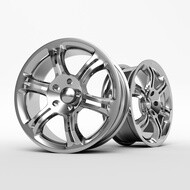
Tips & advice for car and suv tyres
Do you want to change the size of your tyres? It is possible, but there are some restrictions. In this article, we go through them.
What is the size of a tyre?
When we talk about the size of a tyre we are actually talking about its dimension, which include the following elements found on the sidewall of the tyre:

- The width (e.g. 205) in millimetres.
- The aspect ratio (e.g. 55) in percent. This is the ratio between the height of the sidewall of a tyre and the width of the tyre.
- The type (e.g. R for radial)
- The diameter (e.g. 17) in inches.
- The load rating (ex: 91) This number is an index that corresponds to a maximum load that can be supported by a single tyre.
- The speed rating (e.g. V) This letter is an index that corresponds to the maximum speed at which a tyre can carry its maximum load.
What size changes are possible?

On a vehicle, there is the standard fitment proposed by the manufacturer as well as optional fitments, which provide several alternatives approved by the manufacturer.
Example for a PEUGEOT 308 - 1.2 pure tech of 2021:
195/65 R15 91H
205/55 R16 91V
205/50 R17 93V
225/45 R17 91V
225/40 R18 92V
For example, it is possible to choose a different tyre diameter, usually from three options. A car can have an approved wheel diameter of 15, 16 and 17 inches.
Changing the diameter of the wheels means, of course, replacing the rims, which can be made of sheet metal, like the original ones, or of aluminium, which is lighter and more attractive.
Approvals
The various dimensions provided by the car manufacturer are all approved for the vehicle.
It is very easy to find out which dimensions are approved: they are usually indicated on the sticker in the driver's door or in the owner's manual, sometimes also in the fuel filler flap.
Can I fit a different size than the approved ones?
It is imperative to respect the sizes approved by the manufacturer. In some countries, an exemption is possible provided that the tyre diameter remains within a limit of no more than -2% and +1.5%.
It is recommended that the approved sizes are respected so as not to compromise your safety, that of your passengers and that of other drivers on the road. By choosing non-approved sizes, you could, for example, fit tyres that are too wide and protrude dangerously beyond the width of the vehicle. Or tyres with an insufficient load index, for example for commercial vehicles whose function often involves carrying a load.
In addition, as the speedometer takes into account the diameter of your wheels, the speed displayed on your dial could be inaccurate as well as the number of kilometres on your speedometer.

What are the consequences if I don't respect the homologation?
Even if a margin of tolerance is allowed in some countries, failure to comply with the approved dimensions exposes you to certain risks:
- safety risks
- a fine in the event of a police check
- a refusal to have your vehicle inspected
- not being covered by your insurance in the event of an accident
On the other hand, if you respect the approved dimensions, you benefit from flexibility while avoiding these inconveniences.
When do I have to change my tyre size?
If your vehicle is imported from another continent, it is advisable to ensure that its tyres comply with the local approval provided by the manufacturer.
(R30 and R117 regulations as indicated by the E2 marking on the sidewall of the tyre).
For example, if your vehicle is imported into Europe from the United States, you are legally obliged to adapt to the European homologations and to change the size of your tyres accordingly.
When can I increase or decrease the load or speed rating of my tyres?

Tyres used in winter (winter or 4-season tyres) must be M+S (Mud and Snow) and 3PMSF (3 Peaks Mountain Snow Flakes) approved.
If they are labelled 3PMSF (certified for winter driving on wet or snowy roads), it is legally possible to fit winter tyres with a lower speed rating than that recommended.
This is because drivers reduce their average speed in winter when driving on white roads.
The only constraint is that a label must be affixed inside the vehicle, visible to the driver, to remind him of the maximum speed at which he can drive. However, if the tyre is only marked M+S and not 3PMSF, it is legally forbidden to lower the speed rating since January 2020.
For summer, it is possible to opt for tyres with a higher load index and/or speed rating than that specified by the manufacturer, but in no case should it be lower.
How many tyres should I change at the same time?
It is imperative that all four tyres are re-sized at the same time, not just two tyres on the same axle.
Now that you have all the information you need to change your tyre size, you can use our tyre selector below to find the right tyres for you:

Find a tyre dealer near you in seconds
Search by
Address, City or ZIP code
Car
Locate me
Top 5 cities in Africa
Find the perfect tyre
Enter your vehicle or tyre size
We're searching for your tire...
Wait few seconds we're processing your photo



